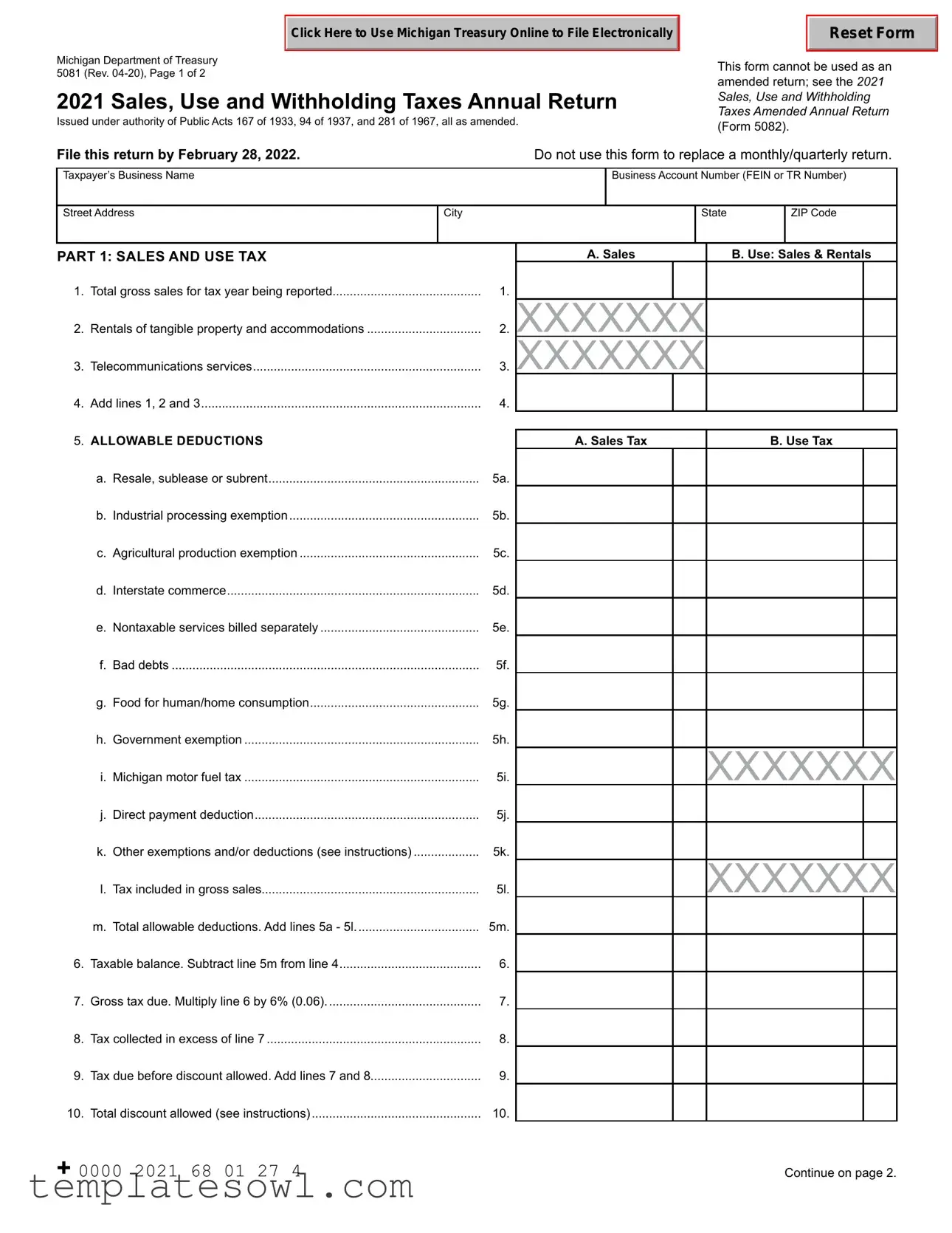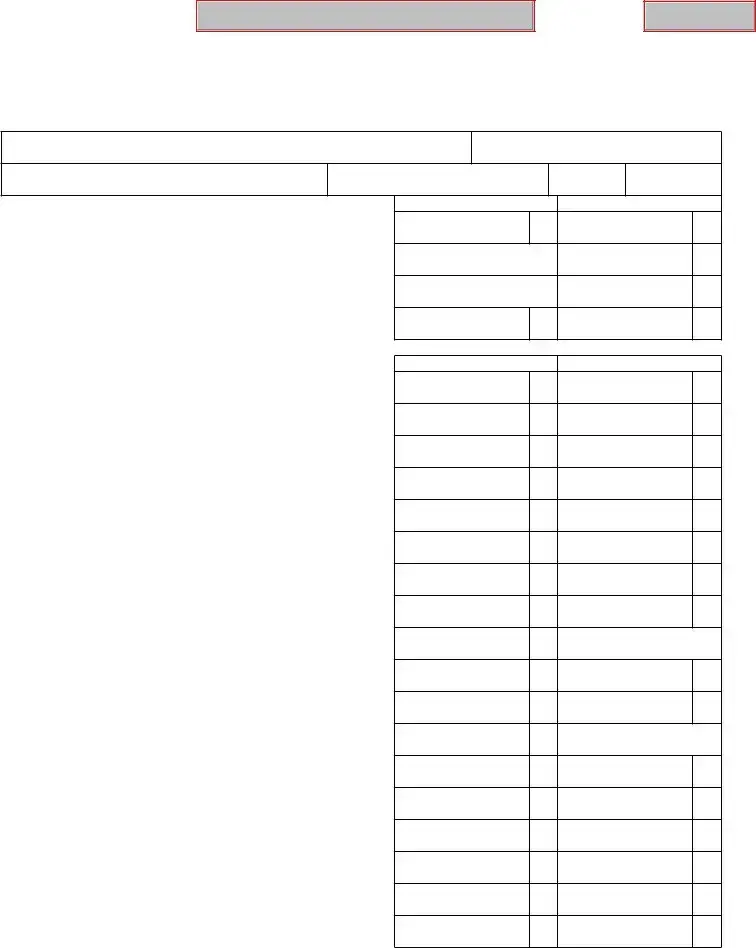2021 Form 5081, Page 4
engaged in a business enterprise that uses or consumes the property for either:
•Tilling, planting, draining, caring for, maintaining, or harvesting things of the soil, or
•Breeding, raising, or caring for livestock, poultry, or horticultural products.
(ii)To the extent that the property is affixed to and made a structural part of real estate for others and used for an exempt purpose in (i), tangible personal property sold to a contractor that is one of the following:
•Agricultural land tile
•Subsurface irrigation pipe
•Portable grain bins
•Grain drying equipment and its fuel or energy source However, the following sales from (i) or (ii) are not exempt:
•Food, fuel, clothing, or similar property for personal living or human consumption, or
•Property permanently affixed to and becoming a structural part of real estate unless it is agricultural land tile, subsurface irrigation pipe, a portable grain bin, or grain drying equipment. Certain property that can be disassembled and reassembled may be exempt.
Some specific types of exempt property and exempt uses of property are clarified in the statute. If property is used for both an exempt and a taxable purpose, the property is only exempt to the extent that it is used for an exempt purpose. In such cases, the exemption is limited to the percentage of exempt use to total use determined by a reasonable formula or method approved (but not required to be pre-approved) by Treasury. For more information, see MCL 205.54a and 205.94.
Line 5d: Interstate Commerce. Enter sales made in interstate commerce. To claim such a deduction, the property must be delivered by the business to the out-of-state purchaser. Property transported out-of-state by the purchaser does not qualify as interstate commerce. Documentation of out-of-state shipments must be retained in business records to support this deduction.
Line 5e: Nontaxable Services Billed Separately. Enter charges for nontaxable services billed separately, such as repair or maintenance, if these charges were included in gross receipts on line 1. Costs, such as delivery or installation charges, that are incurred before the completion of the transfer of ownership of taxable property are included in the tax base and may not be subtracted.
Line 5f: Bad Debts. Bad debts may be eligible for a deduction if the following criteria are met:
•The debts are charged off as uncollectible on business books and records at the time the debts become worthless
•The debts are deducted on the return for the period during which the bad debts are written off as uncollectible
•The debts are or would be eligible to be deducted for federal income tax purposes.
A bad debt deduction may be claimed by a third-party lender if the retailer who reported the tax and the lender financing the sale timely execute and maintain a separate written election designating which party may claim the deduction. Certain additional conditions must be met. See MCL 205.54i, 205.99a, and RAB 2019-3.
Line 5g: Food for Human/Home Consumption. Enter the total of retail sales of grocery-type food, excluding tobacco, marihuana products, and alcoholic beverages. Prepared food is subject to tax. See MCL 205.54g and MCL 205.94d for more information.
Line 5h: Government Exemption. Direct sales to the United States government or the state of Michigan or its political subdivisions are exempt.
Line 5i: Michigan Motor Fuel Tax. Motor fuel retailers may deduct the Michigan motor fuel taxes that were included in gross sales on line 1 and paid to the State or the distributor.
Line 5j: Direct Payment Deduction. Enter sales made to purchasers that claimed direct pay exemption from sales and use taxes. With the exemption claim, the purchaser must include the following statement: “Authorized to pay use tax on purchases of tangible personal property directly to the State of Michigan under Account Number [listing either the Federal Employer Identification Number or the Michigan Treasury Registration Number]. If using Michigan Sales and Use Tax Certificate of Exemption (Form 3372), check the box in Section 3 for “Other” and include the above statement as the explanation. MCL 205.98.
Line 5k: Other Exemptions and/or Deductions. Identify exemptions or deductions not covered in items 5a through 5j on this line. Examples of exemptions or deductions are:
•Allowable trade-in values on vehicle sales. Motor vehicle, recreational vehicle, and watercraft dealers may be eligible to deduct the value of a trade-in under MCL 205.51(d). Deduction for motor vehicles is subject to limitation.
Taxes paid to Secretary of State are not reported here. Instead, they are reported on the Vehicle Dealer Supplemental Schedule (Form 5086, e-file only).
•Credit for the core charge attributable to a recycling fee, deposit, or disposal fee for a motor vehicle or recreational vehicle part or battery if the recycling fee, deposit, or disposal fee is separately stated on the invoice, bill of sale, or similar document given to the purchaser.
•Direct sales, not for resale, to certain nonprofit agencies, churches, schools, hospitals, and homes for the care of children and the aged, to the extent the property is used to carry out the nonprofit purpose of the organization. For sales to certain nonprofit agencies, the exemption is limited based on the sales price of property used to raise funds or obtain resources. All sales must be paid for directly from the funds of the exempt organization to qualify.
•Assessments imposed under the Convention and Tourism Act, the Convention Facility Development Act, the




